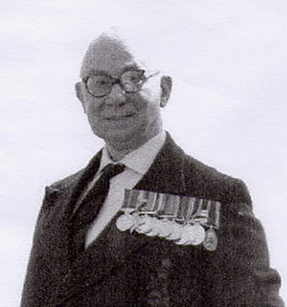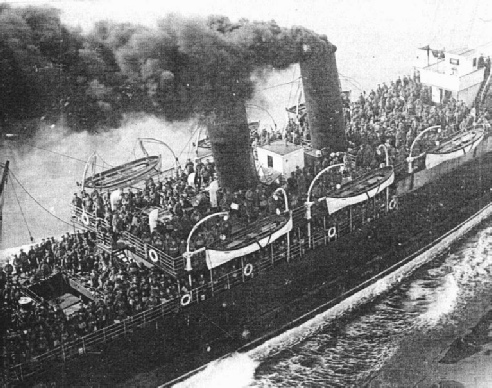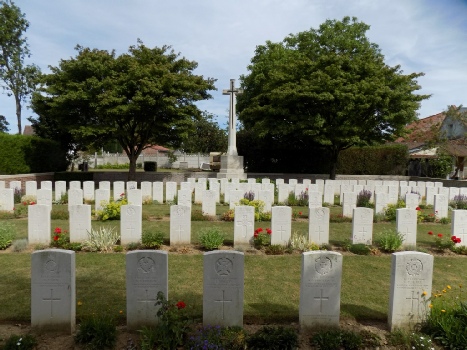22nd DECEMBER 1916.
My leave being over I left Victoria at 7.30 a.m. and journeyed to Folkestone. There we stayed in some empty boarding houses until it was time to sail. I could not help thinking how war had changed Folkestone. Three years ago the boarding houses would have contained holiday makers. Now they contain England's defenders, men in khaki, men of all branches of the service, waiting to return to France, some never to see England again.
At last we got on board and started our journey over the water. It was a glorious day and many a man had a lump in his throat as he watched England's coast disappear. Boulogne was reached safely and we stayed the night in a rest camp up by the wireless station.
23rd DECEMBER 1916.
At 4.30 a.m. our train left for the firing line, or rather the nearest point to it. This was La Gorgue which was reached at 1.30 a.m. on Christmas Eve.
24th DECEMBER 1916.
Can you imagine my feelings as I walked the cobbled streets of France. What a time I might be having were I in London on this night.
25th DECEMBER 1916.
Having slept off the effects of my journey I awoke this morning, it being Christmas Day. Needless to say we made the best of this day also Boxing Day. The Festivities being over we turned to the serious side of things.
27th DECEMBER 1916.
We left the trenches and went to Merville for 12 days during which time each Company had a dinner. Leaving Merville we went to trenches again, holding advance posts in front of Aubers Ridge. Our transport stayed at Larentu. Whilst here they put one or two shells into the village. One of them came into our billet but did not explode. Our casualties at the advanced post numbered 160 in six days.
1st MARCH 1917.
We left Larentu for a supposed six weeks' rest. We arrived at La Gorgue the same day and here we stayed for one night after which we set out for St Floris where we stayed for another night. Next morning we started for Sachem and another night was spent there. The next morning we were off again spending the night at Willeman.
After yet another night's rest we started at 6 a.m. and marched to Regnaville. Here we were supposed to do our 6 weeks' rest but luck was against it. At 1 o'clock in the morning orders came up to the effect that the Germans were on the run so, of course, off we went again, stopping for a night at each of the following places, Rugifay, Iverney. Gouy en Artois was at last reached where we stayed for four days. From here we proceeded to Simencourt where we stayed for five days after which we moved to Achicourt. From here we went into the trenches.
Now just a word about our quick move. We marched for eight consecutive days covering about 190 miles. This is a record Brigade march since Mons. Thus we have made 1 Territorial record and 1 Army record since we have been out here.
Now this place Achicourt is the suburb of Arras. It has been a very pretty place. When we reached it, it was absolutely deserted as, owing to our rapid advance, no British troops had been billeted there. Our second day here was one of great excitement. At 10.30 a.m. on the morning of the
25th MARCH 1917.
A German Fokker spotted one of our scouts and gave chase. Now, a scout stands no chance against a Fokker but our scout, nevertheless, turned for the fight. The way both machines turned and twisted about was a sight worth seeing. At last the 'German opened fire and the bullet went through the neck of our observer and killed him. Thus, when the pilot of our machine did get in a suitable position to fire, it was useless as the observer who works the machine gun was dead. One explosive bullet fired from the Fokker penetrated the petrol tank of our machine and following that came a great length of flame. Our machine was on fire but still the pilot fought. Three times he tried to ram the enemy machine but failed. He kept beautiful control of the machine and just managed to clear the village when the man who had been wounded dropped to earth in pieces, burnt up. Then one of the wings dropped off alight and then the engine stopped and the machine plunged to earth. Help soon reached the spot but, needless to say, the pilot had been burnt to death. It was a sight I shall never forget.
26th MARCH 1917.
The next day they shelled the village but, with the exception of destroying a few ruins, there was no harm done.
28th MARCH 1917.
Today I am sitting in my dug-out in someone's back garden. It is 12 feet under the earth and 6 feet long. Steps take you inside. Now a word about the interior. Boards are used to keep the earth from falling in. There is room for four. The enemy have just started to shell the village again - 2.30 p.m. I think there are some casualties this time.
Later. Two men killed.
….to be continued
To mark the 100th anniversary of World War I, we are continuing the serialisation of the diaries of Bugler John McCormack of “A” Company, 9th Battalion, County of London, Queen Victoria’s Rifle. John McCormack is Eileen Oades’ Uncle and Rosemary Monk’s Great Uncle.







